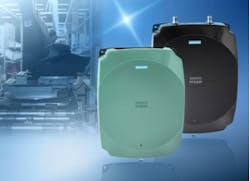RFID RF620R and RF630R Readers
“This bridges the gap between the retail supply chain's use of UHF, RFID technology and the factory floor,” says Michael LaGrega, a Siemens RFID product engineer. “Manufacturing can reap the benefits of not only industrial UHF tags, but they now have UHF readers that are truly designed to be integrated into a manufacturing environment.”
Designed to fit into tight spaces, these stationary readers have an IP65 protection rating and are suitable for use in harsh industrial environments. The RF620R boasts an integrated UHF antenna, while the RF630R can accommodate up to two external UHF antennas. With Simatic RF communication modules, these readers can be integrated directly into Siemens’ S7 PLCs as well as in many common communication networks based on Ethernet (PROFINET, EthernetIP, and TCP/IP) and PROFIBUS protocols. The new readers are capable of reliable selective tag identification, secure data communication, and are suitable for directly identifying objects at read/write distances of up to three meters.
“This allows standard UHF tags to be tracked along the entire process chain from receipt of materials, through production, to finished goods. We feel that this differentiates the Siemens solution at this time,” says LaGrega.
Ideally, these readers will be deployed in the discrete manufacturing space in assembly and materials handling situations, adds LaGrega. “Food and Beverage and packaging are obviously strong fits, but they will add value in any industry that is interested in traceability of work in progress or asset management, including supply chain management, operations, quality control, facilities management, and IT.
“Companies can now benefit from the EPC UHF standards which allow for higher data transmission speeds, longer read distances and lower cost EPC Gen2 inlays while receiving the advantages of industrial RFID algorithms such as command chaining, high-speed digital control, and queued-data scan modes”
For more information, including the RF620R /
RF630R Press Release and RF600 System Brochure, please click here.
For more the RF600 System Manual, please click here.

